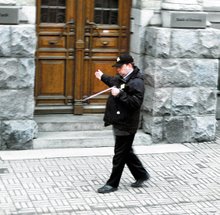According to page 1 of the manual: "Sniffex has four major components: (Fig. 2)"
1. Antenna
2. Casing
3. Two pairs of magnets
4. Proprietary Component ("Container 19")
Page 11 of the manual further explains each component:
Telescoping Antenna – The antenna is the pointer for the device. When Sniffex® detects a nitrous oxide based explosive or a weapon that has been fired, the antenna “points” or rotates in the direction of the explosive or weapon. This rotation occurs as Sniffex® enters into an area containing an abnormally high concentration of nitrous oxide radicals.
Casing - The casing houses two pairs of magnets and “Container 19”. It also serves as an attachment point for the antenna. At the attachment point there is a hinge that allows the antenna to rotate freely.
Magnets – Two pairs of magnets inside the casing create a magnetic charge within the device. One pair is on either side of “Container 19”, which creates the conditions necessary for the interference between the magnetic patterns.
Proprietary Component - The proprietary component (“Container 19”) is a small cylinder contained within the housing component and between the two pairs of magnets. This is the component that separates Sniffex® from all other explosive or weapon detection devices. “Container 19” reacts with the nitrous oxide radicals when it comes into range and excites the radicals specific to the modulation of the magnetic field. The antenna is then able to find and point to the target.
Page 8 of the manual includes the following description of how Sniffex works:
Sniffex® uses a totally different approach. It detects the interference between the magnetic field of the earth, the explosive, the device itself, and the human body which allows the device to penetrate and locate even small amounts of explosives through concrete, soil, and metal barriers.
Sniffex® detects all types of explosives on the basis of the presence of nitrous oxide radicals. Sniffex® operates only when in contact with the hand because of the human body interface.
If you be so kind as to notice, there are NO electronic components within the device. There is also no power source such as batteries, capacitors, solar panels, etc. The antenna swivels freely. It just pivots either from gravity, the wind, or according to TASC, due to the "interference between the magnetic fields of the earth, the explosive, the device itself, and the human body."
Want to know more about the Sniffex? Try looking at the TASC website.
http://tasc.bg/index.htm
Click either one of these links to download the manual from the TASC site or their Czech dealer.
http://tasc.bg/images/Manual.doc













